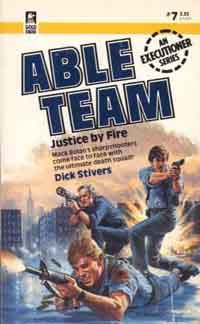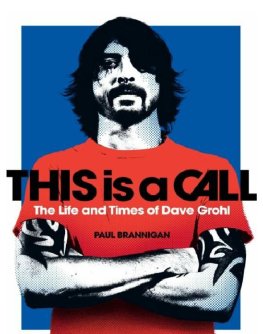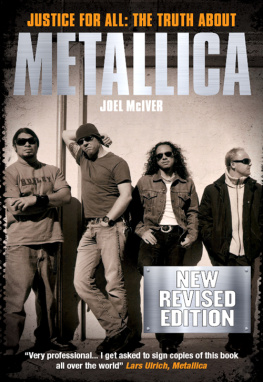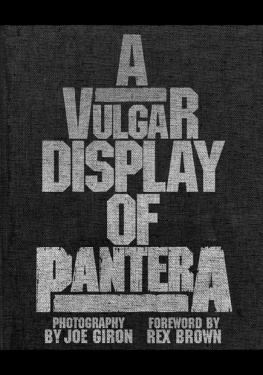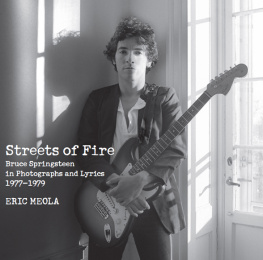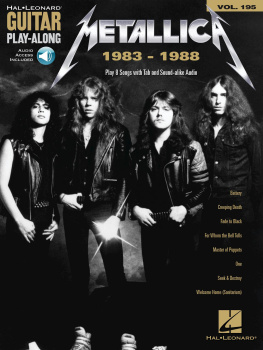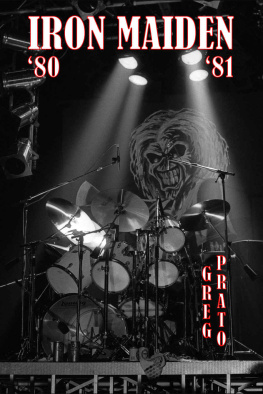BIRTH SCHOOL METALLICA DEATH
Paul Brannigan and Ian Winwood are two of the UKs foremost music writers. Author of the Sunday Times best-seller This Is a Call: The Life and Times of Dave Grohl, Brannigan contributes to Rolling Stone, Classic Rock, Q and Metal Hammer magazines, while Winwood has written for Rolling Stone, the Guardian, Mojo, Kerrang!, NME and the BBC.

VOLUME I

PAUL BRANNIGAN & IAN WINWOOD

DA CAPO PRESS
A Member of the Perseus Books Group
Copyright 2013 by Paul Brannigan and Ian Winwood
All rights reserved. No part of this publication may be reproduced, stored in a retrieval system, or transmitted, in any form or by any means, electronic, mechanical, photocopying, recording, or otherwise, without the prior written permission of the publisher. For information, address Da Capo Press, 44 Farnsworth Street, 3rd Floor, Boston, MA 02210.
Cataloging-in-Publication data for this book is available from the Library of Congress.
First Da Capo Press edition 2013
Reprinted by arrangement with Faber and Faber
ISBN 978-0-306-82187-5 (e-book)
Published by Da Capo Press
A Member of the Perseus Books Group
www.dacapopress.com
Da Capo Press books are available at special discounts for bulk purchases in the U.S. by corporations, institutions, and other organizations. For more information, please contact the Special Markets Department at the Perseus Books Group, 2300 Chestnut Street, Suite 200, Philadelphia, PA 19103, or call (800) 810-4145, ext. 5000, or e-mail .
10 9 8 7 6 5 4 3 2 1
CONTENTS


On June 5, 1993, Metallica drew a crowd of 60,000 rock fans to Milton Keynes Bowl for their first open-air headline show in the United Kingdom. While this deliberately recalled such grand occasions as Led Zeppelins historic two-night stand at Knebworth House in the summer of 1979, the quartets appearance at the verdant man-made arena on that overcast June evening represented a very singular triumph, a triumph of determination and talent over compromise and equivocation. This was a group that had begun their journey not so much on a road less travelled as on a thoroughfare entirely of their own making. In the nine years that had elapsed since the San Franciscan band first played live on British soil, an appearance before just four hundred people at the Marquee club in central London, they had plotted their course to the stages of the worlds largest venues with a ferocity of purpose that was always determined, and sometimes plain perverse. For the longest time, Metallica had resisted playing the standard music industry games, yet despite this actually, because of this the group had acquired millions of fans.
With their 1983 debut album, Kill Em All, Metallica staked their claim to be the fastest, heaviest metal band on the planet. Three years later their pivotal Master of Puppets album sold one million copies worldwide without a single, a promotional video or any support from mainstream radio or television, establishing the Bay Area quartet as the most compelling band of that decade. With the 1991 release of their self-titled fifth album universally known as The Black Album this most uncompromising and defiantly independent collective became international superstars.
But even as Metallica shifted the tectonic plates upon which mainstream music stood, their audience affixed themselves to the group with a devotion that was remarkable even by the standards of modern metal. In acknowledgement of this fiercely obsessive fan-base, the band chose the occasion of their European tour in summer 1993 to deliver a most brazen statement. This they issued on the back of a black T-shirt displayed on boards erected behind and above the heads of the merchandise sellers exchanging soft clothing for hard currency at The Bowl on June 5. On its front the faces of the four members of the visiting band were featured, each mans forearms positioned in a manner that resembled the crossbones on the flag of a pirate ship. It was, though, the words emblazoned on the reverse side of this garment that truly kidnapped the imagination:
Birth. School. Metallica. Death.
One might drive oneself mad attempting to replace the third of this quartet of words with the name of a different band. The field occupied by those that might make the claim that life can be distilled down to just four components, only one of which is nominated by choice, is vanishingly small. The Clash, perhaps; Nirvana, probably; the Grateful Dead, certainly. The difference is, of course, that each of these groups exists only in the past, their reputation burnished and buffed by the soft touch of nostalgia. But Metallica made this claim not only in the present tense but at the very first point at which they would not appear foolish. In doing so, the band exalted their own position without seeming to demean that of their audience. Rather than appearing arrogant, Metallica were simply being emphatic. It was a statement of chutzpah and brio entirely typical of the band. Two decades on, this is a group still equipped to make such a claim. And this is the story of their most extraordinary union.

What a long strange trip it has been. Formed in Los Angeles in 1981 by James Hetfield and Lars Ulrich, and fuelled by the influence of Motrhead, the New Wave of British Heavy Metal (NWOBHM) and nihilistic American punk rock, Metallica began life as front-runners of the nascent American thrash metal scene, an underground community powered by fanzines, the trading of badly dubbed cassette tapes and a peer-to-peer buzz gradually amplified from a whisper to a scream. But in the three decades that have elapsed since the release of their debut album, the band have effectively developed into two separate groups. One of these is a crowd-pleasing operation that rolls into motion each summer as the quartet convene in foreign fields and stadia to play songs most of which are more than twenty years old for tens of thousands of people in exchange for appearance fees in excess of a million pounds each night. It would be wrong, however, to suggest that these days Metallica spends its entire time in the pasture. Because for the other Metallica, a group that constantly seeks to stand in opposition to the established order, the fear of becoming creatively irrelevant is a demon that never sleeps. This anxiety has led the quartet to act with a sense of creative and artistic derring-do the fearlessness of which borders on the reckless, as evidenced by their collaboration with Lou Reed on 2011s brutally uncommercial
Next page

